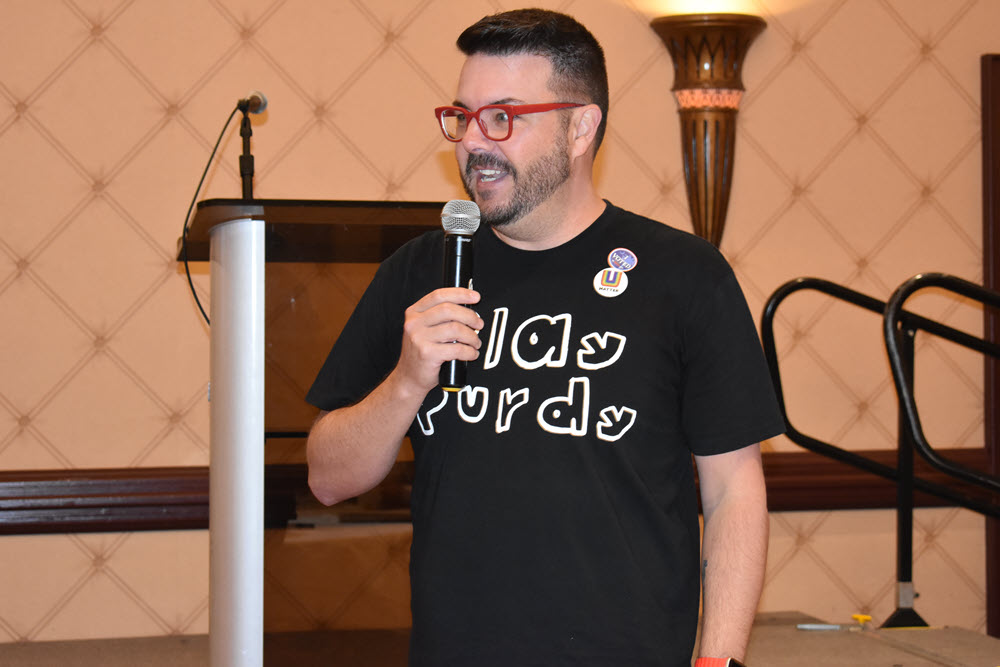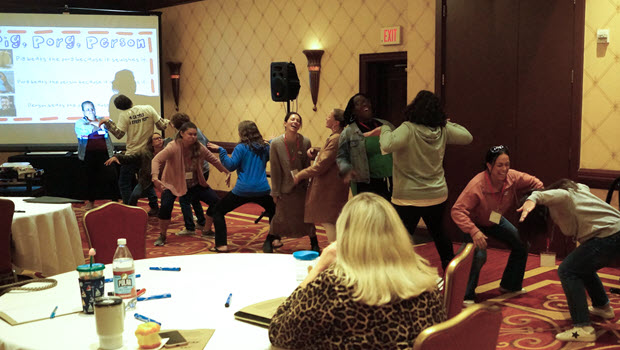“Nurturing connections and building community in our schools takes a lot of different types of activities, and play is crucial in that space,” CEA President Kate Dias told educators this fall at a day of professional learning that explored the balance of human-centered learning in an environment increasingly influenced by technology.
A new state law mandating play-based learning in kindergarten and preschool and allowing its implementation through fifth grade has sparked widespread interest in pedagogical approaches that incorporate play. At the same time, navigating the rapid influx of artificial intelligence has introduced questions and challenges for educators helping students develop critical and creative thinking, collaboration, and communication skills.
“It’s exciting that we’re investing in these areas,” Dias said. “Our students have highly structured schedules, so incorporating play into their learning is increasingly important, as is understanding the role of technology and having a vision for it. We want to be good leaders in these spaces.”
P.L.A.Y.
The power of play and technology were among the key topics discussed at CEA’s third annual Reimagining Education conference, a collaborative venture with the Connecticut Association of Public School Superintendents, Connecticut Association of Schools, and Sacred Heart University’s Isabelle Farrington College of Education and Human Development. Workshops explored topics that included
- Culturally responsive teaching
- Play-based learning and the science of reading
- Building a culture of empathy
- Navigating the challenges and opportunities of artificial intelligence
- Design thinking to foster connection in schools

Jed Dearybury, Milken fellow and winner of the Presidential Award for Excellence in Math and Science Teaching, delivered the keynote address on the transformative power of creativity, empathy, joy, and play in learning.
Thirteen-year veteran classroom teacher Jed Dearybury, a Milken fellow and winner of the Presidential Award for Excellence in Math and Science Teaching, delivered the keynote address on the transformative power of creativity, empathy, joy, and play in learning—a topic he has written about in books that include The Playful Classroom, Courageous Classroom, and The Playful Life.
“A lot of people think play is just for children, but how many of you feel the stress leaving your body as you laugh with me?” he asked, after engaging the audience in humor and movement. “We’ve been taught that play is childish and not for adults, not for all ages. But before you can invite play into your learning space, it has to be part of your life.”
Dearybury recalled a teacher he’d had in elementary school who was an integral part of what he calls his “play history.”
Now a middle school science teacher in her sixtieth year of teaching, Sara Austin spent the first part of her career as a K-5 physical education teacher.
“Even though she dreamed of teaching science, P.E. was the only job they’d give a Black teacher in 1964, when schools in the South integrated,” Dearybury explained. “In every role,” he added, “she made learning fun and meaningful. She was part of my play history and my learning journey, and you can be that for someone too.”
With play largely disappearing from classrooms in recent years, Dearybury notes, children’s ability to positively connect with each other has diminished as well.
 “Play not only helps us connect with others but also become accepting and affirming,” he stressed. “It helps us remember lessons, and make them stick, and feel excitement for learning. People think play is blocks—and it is. People think play is Play-Doh—it is. But it’s also a walk in the woods. It’s sharing a funny story. It’s a lot of things. I like to think of it this way: P is for people, L for learning, A for acceptance, and Y for ‘yee-haw’—the thing that cranks your tractor and gets you excited. For me, that’s a good STEAM lab, an art room, a trumpet, or a piano. For you, it might be something else.”
“Play not only helps us connect with others but also become accepting and affirming,” he stressed. “It helps us remember lessons, and make them stick, and feel excitement for learning. People think play is blocks—and it is. People think play is Play-Doh—it is. But it’s also a walk in the woods. It’s sharing a funny story. It’s a lot of things. I like to think of it this way: P is for people, L for learning, A for acceptance, and Y for ‘yee-haw’—the thing that cranks your tractor and gets you excited. For me, that’s a good STEAM lab, an art room, a trumpet, or a piano. For you, it might be something else.”
Playful learning also solves a surprising number of seemingly unrelated problems, Dearybury pointed out.
“My husband, Matt, used to have trouble with students not getting to class on time. Then one morning, he started a burpee challenge.”
Burpees are a combination of pushups and jump squats, and challenges often involve doing more or doing them faster. Set to AC/DC’s fast-paced, high-intensity hard rock anthem “Thunderstruck,” the classroom burpee challenge started promptly at 7:15 in the morning and was over by 7:30.
“It was a simple, playful thing, but it made kids want to be there early so that they didn’t miss it,” Dearybury said. “Kids from other classes got into it too, and one student suggested they start charting their burpees. So now you have kids showing up to class on time and making line graphs, bar graphs, pie charts! That’s the power of playful learning. Knit your verbs. Dance your way into your literature. Figure out your yee-haw, and your students will reap the benefits.”
For more on the conference, including how to incorporate AI in the classroom, read the next issue of the CEA Advisor, in homes this December.







